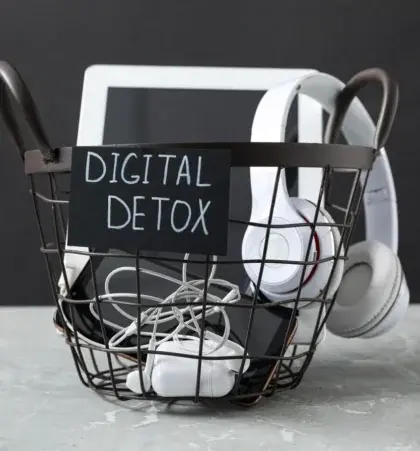Empowering Teens Through Digital Detox
Nowadays, we live in a world full of screens and digital gadgets. The idea of a “digital detox” for teens is important to parents, teachers, and health experts. Teens are using technology more from a young age. Additionally, people worry about how this may affect their growth, happiness, and how they get along with others.
Teens’ addiction to digital gadgets can primarily stem from a variety of factors, including:
- Digital devices give quick rewards, like social media likes or game points. This can make you feel good and keep you coming back, leading to addiction.
- Social Pressure: Teens want to feel accepted by their friends. Many of their friends use digital devices often. Additionally, this makes teens spend a lot of time online or on screens too.
- Escapism: Digital gadgets escape boredom, stress, or other negative emotions. Additionally, teens may turn to screens as a coping mechanism to avoid dealing with real-life challenges or emotions.
- Endless Content: The internet has unlimited entertainment, information, and interactive activities. It’s easy for teens to become absorbed and forget about time.
- Lack of Boundaries: Parents or caregivers sometimes don’t set clear limits on screen time. This can cause teens to form habits of using devices too much.
- Design Features: Digital platforms and apps use addicting features. These include notifications, autoplay, and infinite scrolling. They keep teens engaged for a long time. This makes it hard for teens to stop using them.
- Parental Influence: Teens often model their behaviour after their parents or caregivers. Teens are likelier to emulate this behaviour if adults frequently use digital gadgets.
- Educational Use: Even educational content can become addictive if not adequately balanced with other activities. Teens may become overly dependent on digital devices for learning, neglecting other important aspects of their development. Knowing these factors helps parents, educators, and caregivers.
They can act early to lower the risk of teens getting addicted to digital devices.

Balance teens’ lives
This practice aims to balance teens’ lives. It offers them chances to do activities that grow their creativity and imagination. These activities help people move their bodies and stay active. This means you can see and speak directly to the other person, just like you would if you were in the same room. It helps them reduce stress and understand the importance and liveliness of social interaction in the physical world. It can be useful for their holistic growth and development to lead a blissful, contented life.

Let’s talk about how addiction to digital devices harms teens. This includes their physical, mental, and social-emotional health.
- Increased Screen Time: Teens are spending more time than ever using digital devices. Additionally, these devices include smartphones, tablets, and computers. They spend a lot of time on activities that involve screens.
- Physical Health Issues: and Sleep Disruption: Excessive screen time can lead to various physical health problems, including eye strain, headaches, neck and back pain. Additionally, due to exposure to blue light emitted by screens, especially before bedtime the sleep patterns get affected. Using digital devices late at night can harm sleep quality. This may cause tiredness and irritability.
- Sedentary Lifestyle: Sitting and looking at screens for long hours lowers the amount of physical activity teens get.
- Impact on Brain Development: Using digital devices for a long time can impact how the brain develops. This mainly affects attention, memory, and decision-making skills. These changes can harm cognitive abilities and school performance.
- Decline in Social Skills: Too much time on screens can slow the growth of important social skills. These include understanding others’ feelings, talking well, and solving disagreements. Teens might not spend enough time talking directly with others. They often end up alone. Most of their attention is on their devices.
- Emotional Distress: Digital addiction can lead to emotional issues like stress, anxiety, and depression in teens. This happens for a few reasons. People feel unhappy when they look at other people online and compare themselves. Sometimes, they experience bullying on the internet. Additionally, this kind of bullying is called cyberbullying. Or, they fear they are missing out on online activities, known as FOMO.
- Poor Academic Performance: Too much screen time can harm learning and attention. This can cause lower grades. Additionally, it also makes it hard to concentrate on tasks. This difficulty can occur at school or in other places.
Several factors actively drive digital detox trend. For instance, digital content is easily accessible, and technology has become an integral part of our everyday lives. Moreover, this became even more evident during the COVID-19 pandemic, which further increased reliance on digital devices. As a result, these effects highlight why it is crucial to set healthy limits on screen time. Additionally, maintaining a balance between digital activities and real-world experiences is essential. Furthermore, providing clear guidance and support plays a vital role in helping teens develop responsible and mindful technology habits.
A digital detox for teens involves
- Choosing to limit or avoid using electronic devices and screens for a set time to encourage better habits.
- Fostering real–world connections.
- Encouraging alternative forms of play and learning.
- Digital Detox means taking a break from technology. The goal is to relax and disconnect from screens. Additionally, this includes Smartphones, video games, and Computers. Let’s work towards setting a new trend

First Digital Detox rule:
Go slow. Don’t set unachievable targets
“Break free of your devices and go on a digital detox”
Digital Detox Steps:
- Make a gadget list and check whether they are needed
- There is a lot of time for only required gadgets
- Try ‘phone stacking’ in a social meeting or family meal.
- Make an effort to teach teens to give attention to others.
- Find a detox buddy for teens, or you can be the buddy.
- Leave your gadgets at home if you don’t need them. Additionally, teens will see your example and do the same.
- If nothing else seems to help, do not hesitate to seek support from a counselor. After all, detox means removing harmful substances from the body, and in some cases, people may need professional assistance from doctors or specialists to do this safely and effectively.
Conclusion
Digital Detox is a deliberate slow-down that ultimately leads to greater inner peace and a healthier life. Importantly, parents have the ability to give their teens the gift of balance in the digital age. Additionally, They can achieve this through careful guidance and thoughtful decisions. Together, we can embark on this journey with the shared goal of helping teenagers thrive both online and in real life. Additionally, we encourage them to make smart choices not only on the internet but also in their daily lives. Moreover, parents need to actively model the behavior they want their teens to learn about digital detox.
Additionally, to stay updated with the latest developments in STEM research, visit ENTECH Online. Basically, this is our digital magazine for science, technology, engineering, and mathematics. Furthermore, at ENTECH Online, you’ll find a wealth of information.




